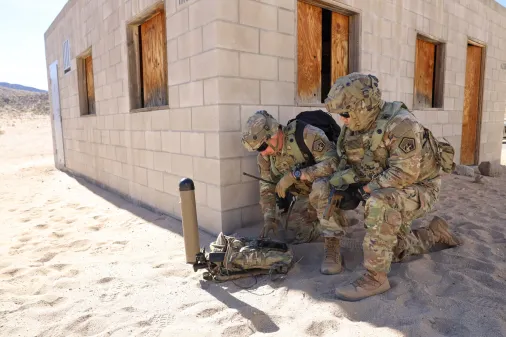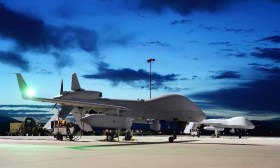Second transforming-in-contact unit putting new tactics to the test in the Pacific for the Army

The Pacific region is forcing the Army to be more intentional with its capabilities and employment.
This is one of the lessons distilled halfway through the rotation at the Joint Pacific Multinational Readiness Center in Hawaii with 2nd Brigade, 25th Infantry Division. That unit is one of three so-called transforming-in-contact units that is helping pioneer and innovate new tactics and employment of technology for the Army.
The brainchild of Chief of Staff Gen. Randy George, the concept envisions using deployments and troop rotations to test new equipment — mainly commercial off-the-shelf gear — that could allow units to be more responsive on a dynamic battlefield. It has initially focused on three main areas where officials say the Army needs to be faster and more adaptable when it comes to delivering equipment to forces, due to how challenging the threat environment is and the cat-and-mouse aspect of countering opponents’ moves: unmanned aerial systems, counter-UAS and electronic warfare.
The first major test for the concept was with 2nd Brigade, 101st Airborne Division at the Joint Readiness Training Center at Fort Johnson, Louisiana, over the summer. Now, 2nd Brigade, 25th ID picks up the transforming-in-contact baton from the 101st with JPMRC Rotation 25-01. The Army has noted this is a continuous process, with officials highlighting that the same exercise controllers at Fort Johnson went out and helped with the 25th Infantry Division, building on lessons and providing planning considerations.
Halfway through their rotation, the unit is already taking away some key lessons. Broadly, service members must be more deliberate in deploying certain capabilities given the challenging terrain of jungle environments and archipelagos, such as a 200-mile air assault from Oahu to Pōhakuloa Training Area where dispersed units need support.
“We’ve had the opportunity to take those lessons learned from 2/101 and implement those here at the Army’s Joint Pacific Multinational Readiness Center training rotation,” Maj. Gen. Marcus Evans, commander of 25th Infantry Division, said in an interview. “I think there’s some other important points to bring up about in terms of what’s different in this training center rotation compared to what 2/101 went through. Number one, the conditions here are different in terms of terrain.”
He noted that there’s much more geographic dispersion there than at Fort Johnson, along with the archipelago environment. That geography makes deploying capabilities more challenging, with Evans adding that until equipment is tested in a tactical scenario and environment, it’s hard to understand exactly how units will fight with it.
“In Hawaii, here where we are, you can’t launch a small unmanned aerial system from anywhere. Oftentimes you’ve got to fight to some high ground so it can get above the canopy. You’ve got to coordinate that … through a mission command system that you need to ensure has the ability to reach back and deconflict airspace,” he said. “The sUAS — we have used these now in the Philippines, here in Hawaii. And the terrain is different in all of those locations, as are the environmental conditions. Depending on what the temperature is, there is less endurance. The hotter it is, the more it drains the batteries and you have to be able to plan around that.”
The division is also learning the importance of battery and power generation. There are many more capabilities now that require batteries, from mission command systems to drones, forcing the unit to think more intentionally about how to plan for battery resupply or recharge the batteries providing the power to these systems. Troops began to experiment with what Evans called a solar stick that can serve as a solar-powered generator instead of driving around with towed generators to juice up the large tactical operation centers, as had been done the past.
Additionally, the makeup of each brigade in the Army is different. The 2nd Brigade, 101st is prototyping the mobile brigade combat team concept and has more Infantry Squad Vehicles than 2nd Brigade, 25th ID, which is prototyping the light brigade combat team concept. But, Evans noted, Infantry Squad Vehicles continue to be an important piece of mobility that provides infantry units the ability to traverse long distances, quickly.
The road terrain, however, is not necessarily conducive for the Infantry Squad Vehicle, forcing units to be more intentional about the routes they plan.
“Probably most important, where are you going to choose to dismount from? Because you can look at the access points in and around the areas in the Pacific in terms of where the roads will go, where they won’t go, and terrain is agnostic to either us or the opposing force,” Evans said. “We have to be able to be very thoughtful in terrain analysis and we’re not able to spread the vehicles out as much as you would be able to … in the area, compared to like Fort Johnson.”
The 2nd Brigade, 25th ID has also started developing more task-organized-for-purpose units and concepts — one being a brigade-level reconnaissance element that can see, sense, strike and execute some of mission command, taken from the development of 2nd Brigade, 101st’s Multifunctional Reconnaissance Company it created.
This new reconnaissance element “can serve far forward. They can see the enemy. They can sense inside the electromagnetic spectrum to enable striking and shaping the fight. We did not plan for that originally,” Evans said. “After the brigade went through a training exercise and then from talking with the 101st, we thought it was a good practice. We did it a little bit differently, just because we don’t have the number of Infantry Squad Vehicles and there’s some less soldiers in the formation, just by the design. But that’s one example, the ability to reorganize — and we call it task-organized for purpose. In this case, it was around the reconnaissance and security fight.”
Soldiers were also innovating with the Silent Tactical Energy Enhanced Dismount, an all-terrain, electric payload mobility platform that is tactically silent with zero emissions and a high load capacity to enhance close combat lethality in dismounted operations, according to the Army.
Evans said soldiers outfitted one to serve as a mission command platform, though not an equipping line product. They developed a form factor that could get onto an aircraft, quickly get off and establish mission command for a battalion commander to work off of.
The network is the number one priority for George, the Army’s top officer. Enabling units to conduct command-and-control and mission command in a dispersed manner across the battlefield while keeping electronic emissions low to avoid detection, will be paramount in future fights against sophisticated adversaries.
“It’s also critically important, a lesson we took from the 101st is you have to be able to hide in plain sight, if you will — the importance of camouflage, but also the importance of deception. Setting up things that look like a mission command post and antennas that give a perception that something is there when it is not, that gets inside of the opposing force or enemies decision calculus and ultimately they have to commit resources, oftentimes to confirm or deny whether or not … that is a mission command post,” Evans said. “That’s one of the lessons learned that [Maj. Gen. Brett Sylvia, commander of the 101st] and I talked about. And certainly, I think they established some best practices that we’ve been able to take on, particularly in deception and agile mission command posts here in the Pacific.”
While units can talk on the move, they must be intentional about when they choose to communicate in order to avoid being detected in the spectrum and targeted with fires.
Multinational
The other distinguishing element for 2nd Brigade, 25th ID’s rotation is the participation of international partners. U.S. Army Pacific has put a premium on boosting partner capacity and interoperability in the Pacific.
In fact, following this current rotation, the brigade will head out to the Philippines to do a rotation with their army in spring 2025.
For the time being, there is a Japanese battalion as part of the training unit with 2nd Brigade and a Malaysian platoon working the sustainment brigade that’s providing logistics. There are also 11 C-17 transport aircraft, one from Australia, as well as British crews providing the ability to project combat power and support units dispersed across the environment.
“One of our goals was to be able to have a mission command network with our multinational partners that we could have a common operating picture in an unclassed [unclassified] environment. By and large, we’ve been able to achieve that,” Evans said. “That’s something we want to continue to iterate on in the Philippines. We did not do that as well as we could have the last time we were in the Philippines. We’re doing it better right now and we still have some room for improvement, but that’s one of our training objectives, not only in this rotation, but particularly when we go back into the Philippines in the springtime period.”
Evans described three types of partner interoperability: personal interoperability solider-to-soldier, procedural interoperability through a combined operations center, and digital interoperability.
While the first two have been demonstrated well, Evans said the third still needs improvement.
“We would like eventually to be at a point where a partner force can observe a threat and they can pass that threat back to, in this example, back to a U.S. operation center and that U.S. operations center will pass it down to another partner nation artillery battery, as an example, to conduct an indirect fire mission,” he said. “Those are the kind of repetitions and training goals that CTC rotations like JPMRC afford us the opportunity to experiment with.”






